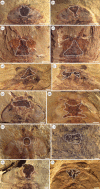Microbial decay analysis challenges interpretation of putative organ systems in Cambrian fuxianhuiids
- PMID: 29643211
- PMCID: PMC5904315
- DOI: 10.1098/rspb.2018.0051
Microbial decay analysis challenges interpretation of putative organ systems in Cambrian fuxianhuiids
Abstract
The Chengjiang fossil Lagerstätte (Cambrian Stage 3) from Yunnan, southern China is renowned for its soft-tissue preservation. Accordingly structures in fuxianhuiids, radiodontans and great appendage arthropods have been interpreted as the nervous and cardiovascular systems, including brains, hearts and blood vessels. That such delicate organ systems survive the fossilization process seems remarkable; given that this mode of preservation involves major taphonomic changes, such as flattening, microbial degradation, chemical alteration and replacement. Here, we document a range of taphonomic preservation states in numerous articulated individuals of Fuxianhuia protensa We suggest that organic (partly iron mineral-replaced) bulbous structures in the head region, previously interpreted as brain tissue, along with sagittally located organic strands interpreted as part of the cardiovascular system or as nerve cords, may be better explained as microbial biofilms that developed following decomposition of the intestine, muscle and other connective tissues, forming halos surrounding the original organic remains.
Keywords: Cambrian; Chengjiang fossil Lagerstätte; cardiovascular system; microbial biofilms; nervous tissue.
© 2018 The Author(s).
Conflict of interest statement
We have no competing interests.
Figures








Similar articles
-
An exceptionally preserved arthropod cardiovascular system from the early Cambrian.Nat Commun. 2014 Apr 7;5:3560. doi: 10.1038/ncomms4560. Nat Commun. 2014. PMID: 24704943
-
Specialized appendages in fuxianhuiids and the head organization of early euarthropods.Nature. 2013 Feb 28;494(7438):468-71. doi: 10.1038/nature11874. Nature. 2013. PMID: 23446418
-
Anamorphic development and extended parental care in a 520 million-year-old stem-group euarthropod from China.BMC Evol Biol. 2018 Sep 29;18(1):147. doi: 10.1186/s12862-018-1262-6. BMC Evol Biol. 2018. PMID: 30268090 Free PMC article.
-
Unlocking the early fossil record of the arthropod central nervous system.Philos Trans R Soc Lond B Biol Sci. 2015 Dec 19;370(1684):20150038. doi: 10.1098/rstb.2015.0038. Philos Trans R Soc Lond B Biol Sci. 2015. PMID: 26554038 Free PMC article. Review.
-
Fossils and the Evolution of the Arthropod Brain.Curr Biol. 2016 Oct 24;26(20):R989-R1000. doi: 10.1016/j.cub.2016.09.012. Curr Biol. 2016. PMID: 27780074 Review.
Cited by
-
Organ systems of a Cambrian euarthropod larva.Nature. 2024 Sep;633(8028):120-126. doi: 10.1038/s41586-024-07756-8. Epub 2024 Jul 31. Nature. 2024. PMID: 39085610 Free PMC article.
-
Early evolvability in arthropod tagmosis exemplified by a new radiodont from the Burgess Shale.R Soc Open Sci. 2025 May 14;12(5):242122. doi: 10.1098/rsos.242122. eCollection 2025 May. R Soc Open Sci. 2025. PMID: 40370603 Free PMC article.
-
Canadia spinosa and the early evolution of the annelid nervous system.Sci Adv. 2019 Sep 11;5(9):eaax5858. doi: 10.1126/sciadv.aax5858. eCollection 2019 Sep. Sci Adv. 2019. PMID: 31535028 Free PMC article.
-
A multiscale approach reveals elaborate circulatory system and intermittent heartbeat in velvet worms (Onychophora).Commun Biol. 2023 Apr 28;6(1):468. doi: 10.1038/s42003-023-04797-z. Commun Biol. 2023. PMID: 37117786 Free PMC article.
-
Cambrian comb jellies from Utah illuminate the early evolution of nervous and sensory systems in ctenophores.iScience. 2021 Aug 4;24(9):102943. doi: 10.1016/j.isci.2021.102943. eCollection 2021 Sep 24. iScience. 2021. PMID: 34522849 Free PMC article.
References
-
- Hou XG, Bergström J. 1997. Arthropods of the Lower Cambrian Chengjiang fauna southwest China. Fossils Strata 45, 1–116.
-
- Shu DG, et al. 1999. Lower Cambrian vertebrates from south China. Nature 402, 42–46. (10.1038/46965) - DOI
Publication types
MeSH terms
Associated data
LinkOut - more resources
Full Text Sources
Other Literature Sources

